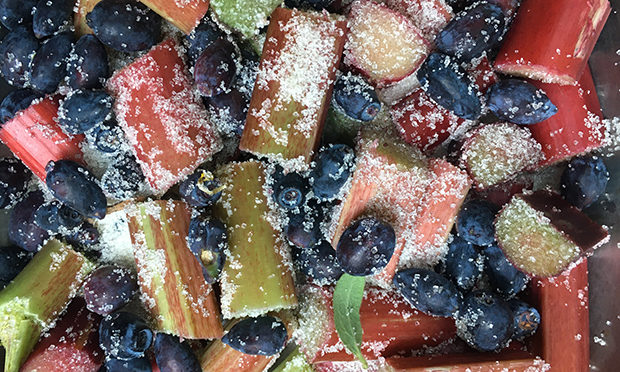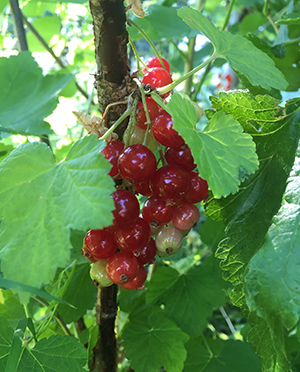The Citizen Gardener: Strawberries aren’t the only summer fruit

My blackcurrants have failed this year. I think maybe the cold spell deterred pollinators so the berries haven’t developed.
Along with tomatoes, blackcurrants are what I look forward to most in the gardening year. I love the tart, heady taste and the fragrant leaves. I also adore picking them.
Picking berries used to be a tedious chore – repetitive, unrewarding and slightly overwhelming. So small, so many. At peak summer – early July to August – I’d have redcurrant, gooseberry, and blackcurrant bushes laden with fruit. I’d find that daunting. I’d tug a handful off the plants and get bored, often leaving bunches of blackcurrants or trails of redcurrants on the bushes for the birds.
Something’s changed though (possibly just perspective) and now I long for the berries to ripen so that I can sit among the bushes hunting them down and picking them one by one. It forces me to relax and slow down. I’d happily sit for hours under a blackcurrant bush relishing in the scent of the leaves and the quiet monotony of searching and picking my sometimes elusive quarry.
When I get them home I stew or bake them with sugar and eat them for breakfast. If I have too many for now, they are great for freezing and lighting up mid-winter nights.
Anyway, enough of this eulogy. I suppose I’m just saying: grow berries. They are easy, perennial, excellent for wildlife and bring great pleasure. And if you have a big enough variety, if one fails, you’ve got many more.
Below is a list of the berries I grow (and one I don’t) and a picking joy rating. If you still hate picking, the birds will relieve you of that chore. Cover them with netting (tightly so birds don’t get tangled in it) if you don’t want to share. Most berries can be grown in pots but they all like sunny to light shade conditions. A good supplier for plants is Walcot Organic Nursery.
Blackcurrants. Queen, in my opinion, of the berry. The leaves can be used for tea. They like a rich soil so I mulch in winter with good compost. Make the best jam on earth. Picking fun 10/10.
Honey berries. An edible member of the honeysuckle family. I’ve been growing them for three years and their flavour is fairly unremarkable but are no bother to grow and fun to pick. They form small neat bushes. They need sugar when you cook them, like most berries. I combine them with rhubarb. Picking fun 8/10.

Photograph: Kate Poland
Redcurrants and white currants. Their flavour is less interesting than blackcurrants but just as enjoyable to pick and give abundant crops. Good for jams and jellies. Picking fun 9/10.
Blackberries. You can get thornless varieties which are similar to the wild ones, but easier to tame and have larger fruit. They are big, though and need a lot of space. I am impatiently waiting for my Merton Thornless and Waldo to fruit. Picking fun 9/10.
Jostaberries. These are a hybrid of a blackcurrant and gooseberry. I find them a bit dull, taste-wise but are reliable and always yield a good crop. Looking good for this year. Picking fun 8/10.
Blueberries are popular but I’ve never grown them. Because they like acid soil and won’t perform well in the wrong type, buy ericaceous compost and grow in a pot. I have heard, though never tried, that you can make your own ericaceous compost using recycled Christmas trees!
Strawberries are always a surprise: how could anything be so luscious in a temperate climate? They seem like they should be found in places where mango and papaya grow. Home grown ones are much less sugary than the ones in the shops which tend to be one type – Elsanta – and are like eating a spoonful of granulated sugar. They are so easy to propagate; they send out runners from the mother plant. I use a hair grip to hold the runners down until they take root. Mulch with straw when the berries ripen to stop them touching the earth and rotting (or being eaten by ground- dwelling creatures). They need rich soil, sun and space to spread. The wild and alpine strawberries are small and have a fragrant taste which is unbeatable. They will travel where they want. The leaves are edible, too. Picking fun 6/10 (not challenging enough).
Gooseberries. Although most are very sour, you can get dessert varieties that are sweeter if left to ripen on the bush. I have a red one – Whinham’s Industry which doesn’t need sugar. They need almost no attention. Perhaps a bit of thinning out in May and pruning in winter. Picking fun reduced by thorns but a good challenge. Picking fun 7/10.
Raspberries are hungry and thirsty so it’s good to mulch them with lots of compost in autumn and spring. There are summer and autumn fruiting varieties. You prune autumn types in late winter and cut all the canes down to the ground. Summer ones get just their old canes pruned as they fruit on the second year’s growth. They will take over if you let them and will spread via roots. Picking fun 7/10.
Pandemic Artefacts
I was just in the locksmiths and the man who worked there had spent the last ten years (he has a nine-year-old daughter) working six days a week.
For the first month of the pandemic, he shut the shop and realised what he’d been missing with his child. Now he doesn’t open for the sixth day of the week, spends that day with his child and is happier.
I, like everyone, have had scores of conversations like this – people reassessing what’s happening in their lives – and choosing home, family, neighbours, and nature. The latter, or at least a surge in an interest in gardening, resulted last year in a shortage of seeds, compost and plants and a spike in the number of people wanting and needing to be in nature and the garden.
The Horticulture Trades Association estimate that an extra three million people have started gardening. Hopefully the enthusiasm will continue and contribute to a wider appreciation of the importance of plants and nature to our health.
Hackney Museum is looking for artefacts that represent the pandemic for us for an exhibition next year and I am thinking that this shift, even if temporary, is something we should exhibit.
Can you bottle and display the joy of picking berries or a walk in the woods?
Kate Poland is an award-winning community gardener and the UK’s first ever postcode gardener in E5. For more, head to cordwainersgrow.org.uk and friendsoftheearth.uk.
